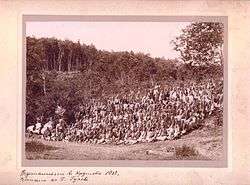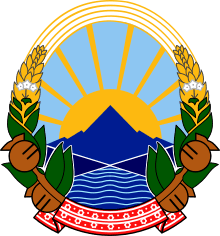Kruševo Republic
| Republic of Kruševo Крушевска Република | |||||||||
|---|---|---|---|---|---|---|---|---|---|
| 1903–1903 | |||||||||
 Flag | |||||||||
|
Motto: "Свобода или смърть" "Freedom or Death" | |||||||||
| Capital | Kruševo | ||||||||
| Government | Republic | ||||||||
| President | |||||||||
• 1903 | Nikola Karev | ||||||||
• 1903 | Vangel Dinu | ||||||||
| Historical era | Ilinden–Preobrazhenie Uprising | ||||||||
• Established | 3 August 1903 | ||||||||
• Disestablished | 13 August 1903 | ||||||||
| |||||||||
| Today part of |
| ||||||||
The Kruševo Republic (Bulgarian and Macedonian: Крушевска Република, translit. Kruševska Republika) was a short-lived political entity proclaimed in 1903 by rebels from the Secret Macedonian-Adrianople Revolutionary Organization (IMARO) in Kruševo during the anti-Ottoman Ilinden–Preobrazhenie Uprising.[1] According to subsequent Bulgarian and Macedonian narratives, it was one of the first modern-day republics on the Balkans.
History
On 3 August 1903, the rebels captured the town of Kruševo in the Manastir Vilayet of the Ottoman Empire (present-day Republic of Macedonia) and established a revolutionary government. The entity existed only for 10 days: from August 3, to August 13, and was headed by Nikola Karev.[2] He was under strong leftist influence, rejecting the nationalism of the ethnic minorities and favouring as the alliances with ordinary Muslims against the Sultanate, as well the idea about a Balkan Federation.[3]
Amongst the various ethno-religious groups (millets) in Kruševo a Republican Council was elected with 60 members – 20 representatives from each one: Aromanians (Vlachs); Slav-, Vlach- and Albanian-speaking Greek Patriarchists and Macedonian Bulgarians (Exarchists).[4][5][6][7] The Council also elected an executive body – the Provisional Government, with six members (2 from each mentioned group),[8] whose duty was to promote law and order and manage supplies, finances, and medical care. The "Kruševo Manifesto" was published. Written by Nikola Kirov, it outlined the goals of the uprising, calling upon the Muslim population to join forces with the provisional government in the struggle against Ottoman tyranny, in order to attain freedom and independence.[9] Both Nikola Kirov and Nikola Karev were members of the Bulgarian Workers' Social Democratic Party, from where they perceived these leftist ideas.[10]
However Karev called the members of the local Council "brother Bulgarians", while the insurgents flew Bulgarian flags, killed five Greek Patriarchists, accused to be Ottoman spies, and subsequently assaulted the local Muslims (Turks and Albanians). As long as the town was controlled by the IMARO komitadjis, the Patriarshist majority was suspected and terrorized.[11]
Initially surprised by the uprising, the Ottoman government took extraordinary military measures to suppress it. After fierce battles near Mečkin Kamen, the Ottomans managed to destroy the Kruševo Republic, committing atrocities against the rebel forces and the local population.[12] Today an enormous monument on the hill above Kruševo marks the elusive dream of the Ilinden revolutionaries. In the area there is another monument called Mečkin Kamen. This was the place where Pitu Guli's band (cheta) tried to defend the town of Kruševo from Ottoman troops coming from Bitola. The whole band and their leader (voivode) perished. As result of the gunnery, the town was set partially ablaze.[13]
Modern references

During World War II in Yugoslav Macedonia, then annexed by Bulgaria, the newly organized Macedonian communist partisans, developed the idea of some kind of continuity between their struggle and the struggle of the insurgents in Kruševo.[14] Moreover, they exhorted the population to struggle for "free Macedonia" and against the "fascist Bulgarian occupiers". After the War the story continued in the Socialist Republic of Macedonia, where the Kruševo Republic was included in its national pantheon. The new Communist authorities successfully wiped out the remaining Bulgarophile sentiments.[15] As part of the efforts to prove the continuity of the new Macedonian nation and the former insurgents, they claimed the IMARO-activists, had been consciously Macedonian in identity.[16] The establishment of the short-lived entity is seen today in the Republic of Macedonia as a prelude to the independence of the modern Macedonian state.[17]
Nevertheless, Macedonian historians such as Blaže Ristovski have recognized, that the entity, nowadays a symbol of the Macedonian statehood, was composed of people who identified themselves as "Greeks", "Vlachs," and "Bulgarians".[18][19][20] In the early 20th century, Kruševo was populated by a Slavic population, Aromanians and Orthodox Albanians with town inhabitants being ethno-religiously split among various Ottoman millets, with Greek Patriarchists being the largest community, followed by Bulgarian Exarchists and the Vlach (Ullah) millet.[21][22][23] When the anthropologist Keith Brown visited Kruševo at the eve of the 21th century, he discovered that the local Aromanian dialect has no way to distinguish "Macedonian" and "Bulgarian", and uses the designation Vurgari, i.e "Bulgarians", about both ethnic groups.[24]
See also
Part of a series on the |
|---|
| History of the Republic of Macedonia |
 |
| Chronological |
|
| Topical |
| Related |
|
|
References
- ↑ There was even an attempt to form a kind of revolutionary government led by the socialist Nikola Karev. The Krushevo manifesto was declared, assuring the population that the uprising was against the Sultan and not against Muslims in general, and that all peoples would be included. As the population of Krushevo was two thirds hellenised Vlachs and Patriarchist Slavs, this was a wise move. Despite these promises the insurgent flew Bulgarian flags everywhere and in many places the uprising did entail attacks on Muslim Turks and Albanians who themselves organised for self-defence.” Who are the Macedonians? Hugh Poulton, C. Hurst & Co. Publishers, 1995, ISBN 1850652384, p. 57.
- ↑ Historical Dictionary of the Republic of Macedonia, Dimitar Bechev, Scarecrow Press, 2009, ISBN 0810862956, p. 114.
- ↑ "It would nevertheless be far-fetched to see in the Macedonian socialism an expression of national ideology... It is difficult to place the local socialist articulation of the national and social question of the late 19th and early 20th centuries entirely under the categories of today's Macedonian and Bulgarian nationalism. If Bulgarian historians today condemn the “national-nihilistic” positions of that group, their Macedonian colleagues seem frustrated by the fact that it was not "conscious" enough of Macedonians' distinct ethnic character." Entangled Histories of the Balkans – Volume Two, Roumen Daskalov, Diana Mishkova, BRILL, 2013, ISBN 9004261915, p. 503.
- ↑ Contested Ethnic Identity: The Case of Macedonian Immigrants in Toronto, 1900–1996, Chris Kostov, Peter Lang, 2010, ISBN 3034301960, p. 71.
- ↑ Fieldwork Dilemmas: Anthropologists in Postsocialist States, Editors Hermine G. De Soto, Nora Dudwick, University of Wisconsin Press, 2000, ISBN 0299163741, pp. 36–37.
- ↑ Tanner, Arno (2004). The Forgotten Minorities of Eastern Europe: The history and today of selected ethnic groups in five countries. East-West Books. p. 215. ISBN 952-91-6808-X.
- ↑ The past in question: modern Macedonia and the uncertainties of nation, Keith Brown, Publisher Princeton University Press, 2003, ISBN 0-691-09995-2, pp. 81–82.
- ↑ We, the People: Politics of National Peculiarity in Southeastern Europe, Diana Mishkova, Central European University Press, 2009, SBN 9639776289, p. 124.
- ↑ Pål Kolstø, Myths and boundaries in south-eastern Europe, Hurst & Co., ISBN 1850657726, p. 284.
- ↑ Mercia MacDermottFreedom Or Death: The Life of Gotsé Delchev, Pluto Press, 1978, ISBN 0904526321, p.386.
- ↑ Michael Palairet, Macedonia: A Voyage through History (Vol. 2), Cambridge Scholars Publishing, 2016, ISBN 1443888494, p. 149.
- ↑ P. H. Liotta, Dismembering the State: The Death of Yugoslavia and why it Matters, Lexington Books, 2001, ISBN 0739102125, p. 293.
- ↑ John Phillips, Macedonia: Warlords and Rebels in the Balkans, I.B.Tauris, 2004, ISBN 0857714511, p. 27.
- ↑ Roumen Daskalov, Diana Mishkova, Entangled Histories of the Balkans – Volume Two: Transfers of Political Ideologies and Institutions, BRILL, 2013, ISBN 9004261915, p. 534.
- ↑ Contested Ethnic Identity: The Case of Macedonian Immigrants in Toronto, 1900-1996, Chris Kostov, Peter Lang, 2010, ISBN 3034301960, p. 84.
- ↑ James Frusetta "Common Heroes, Divided Claims: IMRO Between Macedonia and Bulgaria". Central European University Press, 2004, ISBN 978-963-9241-82-4, pp. 110–115.
- ↑ The political and military leaders of the Slavs of Macedonia at the turn of the century seem not to have heard the call for a separate Macedonian national identity; they continued to identify themselves in a national sense as Bulgarians rather than Macedonians.[...] (They) never seem to have doubted “the predominantly Bulgarian character of the population of Macedonia". "The Macedonian conflict: ethnic nationalism in a transnational world", Princeton University Press, Danforth, Loring M. 1997, ISBN 0691043566, p. 64.
- ↑ "Беше наполно прав и Мисирков во своjата фундаментална критика за Востанието и неговите раководители. Неговите укажуваньа се покажаа наполно точни во послешната практика. На пр., во ослободеното Крушево се формира градска управа составена од "Бугари", Власи и Гркомани, па во зачуваните писмени акти не фигурираат токму Македонци(!)..." Блаже Ристовски, "Столетиjа на македонската свест", Скопjе, Култура, 2001, стр. 458.
- ↑ "We, the People: Politics of National Peculiarity in Southeastern Europe" Diana Mishkova, Central European University Press, 2009, ISBN 9639776289, p. 124: Ristovski regrets the fact that the "government" of the "republic" (nowadays held to be a symbol of Macedonian statehood) was actually composed of two "Greeks", two "Bulgarians" and one "Romanian". cf. Ristovski (2001).
- ↑ "The IMARO activists saw the future autonomous Macedonia as a multinational polity, and did not pursue the self-determination of Macedonian Slavs as a separate ethnicity. Therefore, Macedonian was an umbrella term covering Bulgarians, Turks, Greeks, Vlachs, Albanians, Serbs, Jews, and so on." Historical Dictionary of Macedonia, Historical Dictionaries of Europe, Dimitar Bechev, Scarecrow Press, 2009, ISBN 0810862956, Introduction.
- ↑ Zografski, Dančo (1986). Odbrani dela vo šest knigi: Makedonskoto nacionalno dviženje. Naša kniga. p. 21. "Населението на Крушево во време на востанието гб сочинуваат Македонци, Власи и Албанци. Први се доселиле во него Власите кон втората половина од XVIII век, односно по познатите грчки востанија од 1769 година..."
- ↑ William Miller, Ottoman Empire and Its Successors 1801–1927: With an Appendix, 1927–1936, Cambridge University Press, 2013, ISBN 1107686598, p. 446.
- ↑ Thede Kahl, The Ethnicity of Aromanians after 1990: the Identity of a Minority that Behaves like a Majority, Ethnologia Balkanica, Vol. 6 (2002), LIT Verlag Münster, p. 148.
- ↑ Chris Kostov, Contested Ethnic Identity: The Case of Macedonian Immigrants in Toronto, 1900-1996, Peter Lang, 2010, ISBN 3034301960, p. 71.